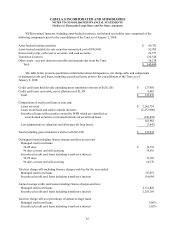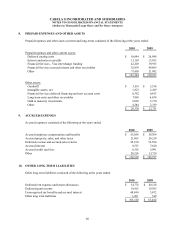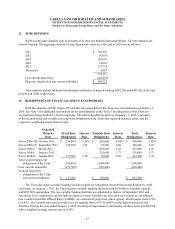Cabela's 2010 Annual Report Download - page 87
Download and view the complete annual report
Please find page 87 of the 2010 Cabela's annual report below. You can navigate through the pages in the report by either clicking on the pages listed below, or by using the keyword search tool below to find specific information within the annual report.77
CABELA’S INCORPORATED AND SUBSIDIARIES
NOTES TO CONSOLIDATED FINANCIAL STATEMENTS
(Dollars in Thousands Except Share and Per Share Amounts)
Financial Instruments and Credit Risk Concentrations – Financial instruments which may subject the
Company to concentrations of credit risk are primarily cash, cash investments, and accounts receivable. The
Company invests primarily in money market accounts or tax-free municipal bonds, with short-term maturities,
limiting the amount of credit exposure to any one entity. At January 1, 2011, the Company had approximately
$45,970 in cash invested in overnight funds at a major financial institution. Concentrations of credit risk on
accounts receivable are limited due to the nature of the Company’s receivables.
Fair Value of Financial Instruments – The carrying amount of cash and cash equivalents, accounts
receivable, restricted cash, accounts payable, gift certificates (including credit card loyalty rewards programs),
accrued expenses, short-term borrowings, and income taxes payable included in the consolidated balance sheets
approximate fair value given the short-term nature of these financial instruments. The estimated fair values of
the Company’s long-term debt instruments are based on the amount of future cash flows associated with each
instrument discounted using current borrowing rates for similar debt instruments of comparable maturity.
Comprehensive Income (Loss) – Comprehensive income (loss) consists of net income, derivative
adjustments, unrealized gains and losses on available-for-sale economic development bonds and asset-backed
available-for-sale securities, and foreign currency translation adjustments, net of related income taxes.
Currency Translation – Assets and liabilities of Cabela’s Canadian operations are translated into United
States dollars at currency exchange rates in effect at the end of a reporting period. Gains and losses from
translation into United States dollars are included in accumulated other comprehensive income (loss) in our
consolidated balance sheets. Revenues and expenses are translated at average monthly currency exchange rates.
Earnings Per Share – Basic earnings per share is computed by dividing net income by the weighted average
number of shares of common stock outstanding during the period. Diluted earnings per share is computed by
dividing net income by the sum of the weighted average number of shares outstanding plus all additional common
shares that would have been outstanding if potentially dilutive common share equivalents had been issued.
2. ACCOUNTING PRONOUNCEMENTS
In January 2010, the Financial Accounting Standards Board (“FASB”) issued Accounting Standards Update
(“ASU”) No. 2010-06, Fair Value Measurements and Disclosures (Topic 820): Improving Disclosures about Fair
Value Measurements. This guidance revises two disclosure requirements concerning fair value measurements
and clarifies two others. This statement requires separate presentation of significant transfers into and out of
Levels 1 and 2 of the fair value hierarchy and disclosure of the reasons for such transfers. It also requires the
presentation of purchases, sales, issuances, and settlements within Level 3 on a gross basis rather than a net
basis. The amendments also clarify that disclosures should be disaggregated by class of asset or liability and that
disclosures about inputs and valuation techniques should be provided for both recurring and non-recurring fair
value measurements. The new disclosures about fair value measurements are presented in Note 25, except for the
requirement concerning gross presentation of Level 3 activity, which is effective for fiscal years beginning after
December 15, 2010. The adoption of this statement had no effect on the Company’s financial position or results of
operations.
In July 2010, the FASB issued ASU No. 2010-20, Disclosures about the Credit Quality of Financing
Receivables and the Allowance for Credit Losses. This guidance enhances the existing disclosure requirements
providing more transparency of the allowance for loan losses and credit quality of financing receivables. The new
disclosures that relate to information as of the end of a reporting period are effective for the Company’s fiscal
2010 year-end reporting. The new disclosures that relate to activity occurring during the reporting period will be
effective beginning with the Company’s first quarter of fiscal 2011.
























